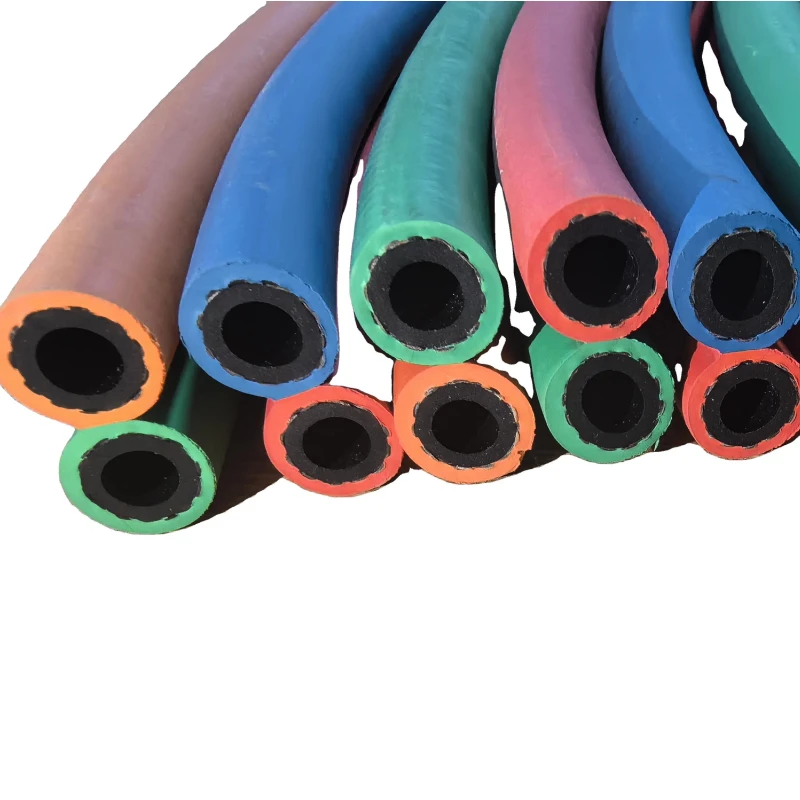0xygen/Acetylene Welding hose
The Oxygen/Acetylene Welding Hose is specifically designed to safely deliver oxygen and acetylene gases used in welding, cutting, and brazing applications. Made from high-quality, flexible synthetic rubber or neoprene, this hose provides excellent resistance to abrasion, heat, oil, and weathering, ensuring durability in demanding work environments. Typically color-coded—green for oxygen and red for acetylene—the hoses help prevent mix-ups and enhance workplace safety. Their dual-layer construction features a smooth inner lining that resists chemical degradation from gas exposure and a reinforced outer layer with braided textile or synthetic fibers, providing high tensile strength and resistance to kinking or bursting under pressure. These hoses can handle high gas pressures and varying temperatures, maintaining flexibility even in cold conditions. The Oxygen/Acetylene Welding Hose is compatible with standard fittings and regulators, allowing secure, leak-free connections essential for safe gas flow. Commonly used in industrial fabrication, automotive repair, and construction, these hoses meet rigorous industry standards to ensure reliable performance and safety during welding operations. Additionally, they are designed for easy handling and long service life, reducing downtime and maintenance costs. Overall, the Oxygen/Acetylene Welding Hose offers safety, flexibility, and durability, making it an essential tool for efficient and secure gas welding and cutting tasks.
What Grade Hose For Oxy-Acetylene?
For oxy-acetylene welding and cutting applications, the recommended hose grade is typically a high-quality, industrial-grade hose specifically designed to handle the unique demands of oxygen and acetylene gases. These hoses are often classified as Grade R or Grade A hoses, which meet stringent standards set by organizations such as the Compressed Gas Association (CGA) and ISO. They are constructed from durable, heat-resistant synthetic rubber or neoprene materials, designed to withstand high pressures, temperature fluctuations, and exposure to oils, chemicals, and abrasion commonly found in welding environments. The hose must have dual-layer construction: a smooth, chemically resistant inner lining compatible with oxygen or acetylene gas, and a reinforced outer cover that resists wear, kinking and bursting. Additionally, these hoses are color-coded—green for oxygen and red for acetylene—to ensure safety and prevent gas mix-ups. Grade R hoses typically offer higher performance and greater resistance to harsh conditions than lower grades, making them suitable for professional and industrial use. It is essential to select hoses that comply with applicable industry standards such as ISO 3821 or CGA specifications to ensure safety, reliability and optimal gas flow. Proper hose selection, maintenance and inspection are critical to preventing leaks or failures, ensuring safe and efficient oxy-acetylene operations. Overall, using the correct grade hose is vital for protecting both the operator and equipment during welding and cutting tasks.
What Is The Difference Between Oxygen And Acetylene Hoses?
The primary difference between oxygen and acetylene hoses lies in their construction, materials, and color coding, all designed to ensure safety and proper functionality during welding and cutting operations. Oxygen hoses are typically green and made from materials that can safely handle high-pressure oxygen without degrading or causing combustion. They have a smooth inner lining resistant to oxidation and are designed to prevent leaks or reactions with oxygen, which is a strong oxidizer. Acetylene hoses, on the other hand, are usually red and constructed to handle acetylene gas, which is highly flammable and can be unstable under pressure. Their inner lining is designed to resist the corrosive effects of acetylene and prevent buildup that could lead to dangerous blockages or flashbacks. Acetylene hoses are often made from a more flexible rubber compound to accommodate the specific properties of acetylene gas. Both hoses feature reinforced outer layers to withstand abrasion, heat, and environmental exposure, but their fittings and safety standards differ to prevent accidental interchange, which could cause hazardous situations. The color coding—green for oxygen and red for acetylene—helps users quickly identify and connect the correct hose to the corresponding gas supply. Proper maintenance and inspection of both hoses are crucial to prevent leaks and ensure safe welding and cutting operations. In summary, oxygen and acetylene hoses are specifically engineered to safely handle their respective gases, with differences in materials, construction and identification to maintain operational safety.





